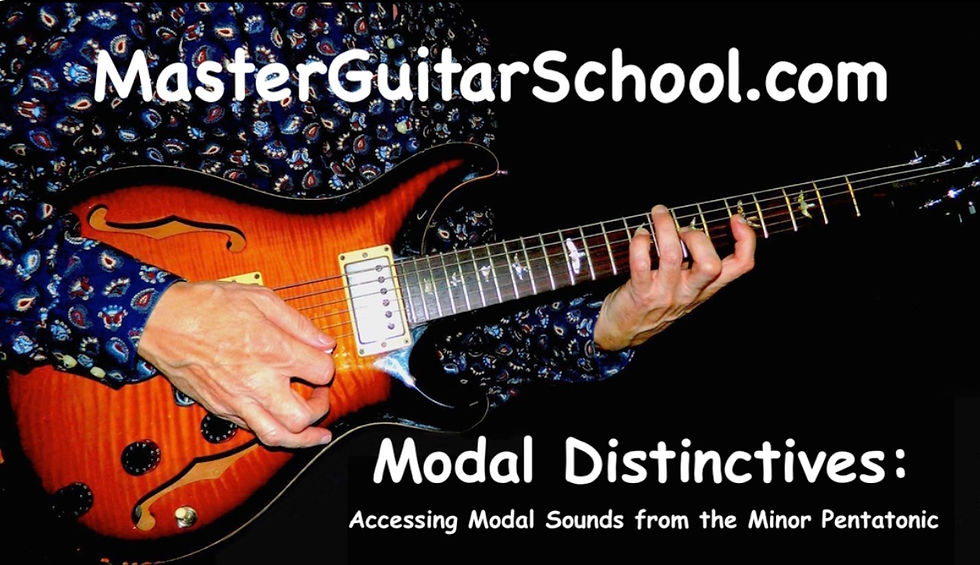Easy Lesson: The Aeolian/Dorian Distinction
- Jay EuDaly

- Oct 24, 2022
- 4 min read
Updated: Jun 8, 2025
Chances are, you're somewhat confused by the whole modal-theory thing; I see expressions of frustration and confusion on the subject all the time on my FaceBook feed coming from the plethora of guitar groups I follow.
Furthermore, a huge percentage of the "answers" in the comments sections are flat-out wrong, or dismissive of the subject, or not very helpful even if correct.
Rather than go through a lengthy explanation of what modes are and where they come from, I'm going to approach this from a more limited and practical viewpoint.
I am starting from something simple and easy to understand, the Minor Pentatonic Scale.
The Minor Pentatonic Scale is usually the first scale one learns, and with good reason; it's the most-used scale, especially among guitarists, and occurs in the music of every culture in the world.
That said, there are many different pentatonic scales; all that's necessary to acquire the nomenclature is that there be 5 tones per octave - thus, "penta" (five) "tonic" (tones).
But we're going to use the one that you are most likely to know. I'll give you two Minor Pentatonic Scale patterns; one with a 6th-string root, and one with a 5th-string root:

The number of each note is based on the notes of the Natural Minor Scale (don't worry about whether you know it or not). As you can see, there are two notes missing; the 2nd and the 6th.
You should drill the above two patterns in every key around the Circle.
If you don't know what I mean by, "around the Circle," you need to stop right here and download the 5-Lesson Foundational Series. This series of lessons teaches the Circle of Keys as an organizational mechanism by which you ensure that whatever you learn is drilled in every key in all possible positions. It also gives you a method to find any note, anywhere, without memorizing note names on every string. That is a beautiful thing!
You can download the 5-Lesson Foundational Series right here for free with no further obligation or commitment:
We're going to simplify things even more by only dealing with the upper octave, which is where most of the soloing activity occurs:

Notice the space between the 5th and the 7th. There is room for two different 6ths.
The 6th closest to the 5th is the Minor 6th; I call it the "Aeolian 6th". The 6th closest to the 7th is the Major 6th; I call it the "Dorian" 6th."
Minor Pentatonic w/Aeolian 6th

Minor Pentatonic w/Dorian 6th

Mess around with the two different 6ths. The more you mess with them the more you train your ear to distinguish between them, the more you perceive the difference in emotional content; the Dorian is brighter - there's a ray of sunshine breaking through the "minor-ness" of the Pentatonic. The Aeolian is darker in sound, maintaining the darker emotional content.
So in any given situation, what do you want to hear? What do you want to feel?
You can make your decision based on those questions rather than some esoteric understanding of modal theory that forces you to go through a convoluted thought process like;
Aeolian and Dorian are minor. If the chord your soloing over is A minor what key are you in? What major scale should you play? Well, II, III and VI are all minor. So if A is II then you are in the key of G. If A is III you are in the Key of F. If A is VI you are in the key of C. II is Dorian, III is Phrygian, VI is Aeolian - I think we're in the key of C so over this Am chord I'm going to play a C major scale from the 6th degree of the scale...ooops, SOLO'S OVER! Thank you for auditioning. Next!
Think rather;
What do I want to hear? What do I want to feel? What color do I want to see?
Yes, I know, in the context of a chord progression, there are other more intellectual issues in play that will require an understanding of modal theory. The example in the video is in the context of an A minor funk groove; no other chords are involved. And in that situation, emotion/sound/color is the primary issue. As far as I'm concerned, even in a more complex harmonic situation, it's still the primary issue.
Want more info on the Aeolian/Dorian distinction? See these related blogs:
If you liked this free lesson, there's a lesson series from MasterGuitarSchool.com called "Modal Distinctives" in which you can learn to easily access the distinctive sound of any mode from the most commonly known scale, the Minor Pentatonic. It is a PDF containing: 36 pages, 6 lessons, 65 fretboard diagrams and other graphics, 6 video links, 28 links to additional lessons, song examples, and more!
Sign up as a Master Guitar School site member - it's free! - and get access to dozens of free site-based lessons, a monthly newsletter that contains a brand-new free lesson, and DEEP discounts on lesson series downloads - plus more! Want more info? Go to Why Become a Site Member?
Leave a comment &/or share through your social networks using the links below!










Comments